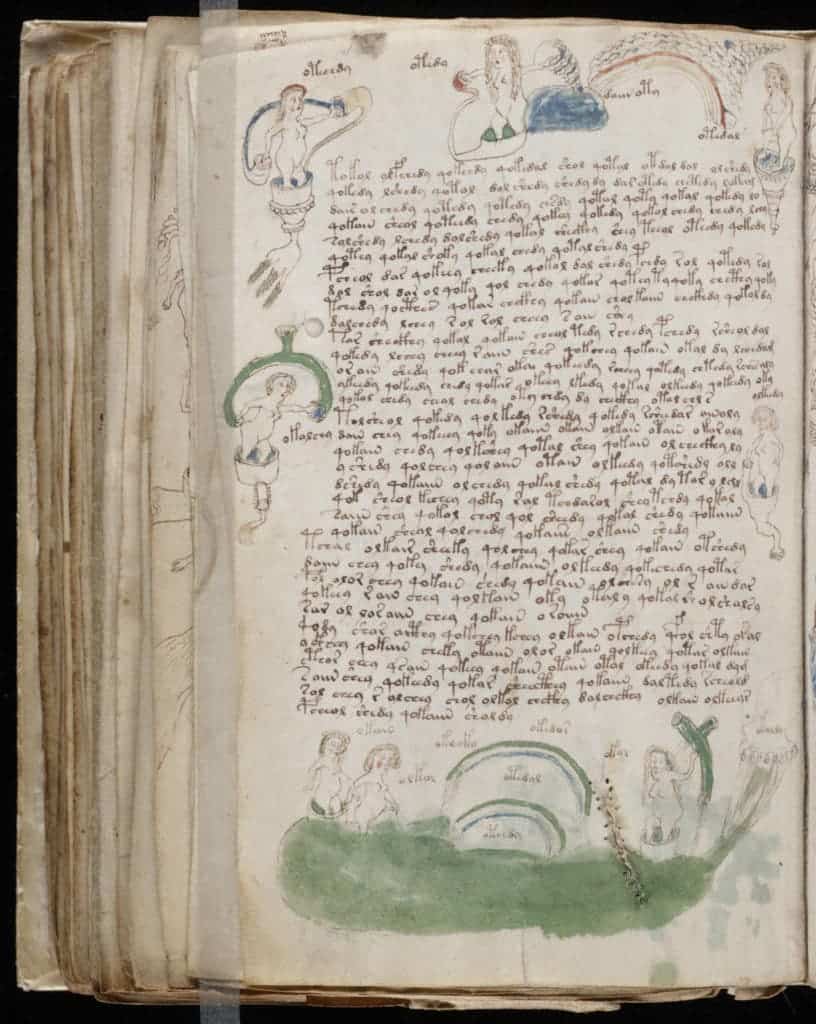
In 1912, a book dealer named Wilfrid Voynich got ahold of an illuminated cipher manuscript once belonging to Emperor Rudolf II (1576–
Ancient gibberish?
Voynich claimed that Roger Bacon — who was a 13th-century monk and philosopher — was the original author of the manuscript. Bacon is a controversial figure who was involved in all areas of science, but also in the occult, as were most scholars of his time. In a work called The Mirror of Alchemy, Bacon mentions the creation of an elixir that he claimed could not only transmute metals, but also prolong life. The “true” procedure might have been concealed in the enciphered Voynich manuscript.
In De Secretis Operibus Artis et Naturae, et de Nullitate Magiae, Bacon describes several techniques for hiding secrets including hiding a message “under characters and symbols” (e.g., use code or jargon), “writing with consonants only”, “commingling letters of various kinds” (combined use of changing the order of the letters and nulls, meaningless symbols inserted randomly), “by means of special letters devised by their own ingenuity and will”, and “using geometric figures that function as letters.”

The Voynich manuscript seems to use a combination of such ciphering techniques, being etched in an unknown wiggly script, which encodes some unknown language. Some of the best cryptographers in the world have had a shot at cracking the Voynich manuscript with nothing to show for it. Of course, various solutions surfaced over the years, but these were dismantled one by one by the crypto and intelligence community.
Some have even gone as far as claiming this is all an elaborate hoax; possibly an ancient one performed by someone trolling Emperor Rudolf’s propensity for alchemy or by Voynich himself, an astute collector but also a former convict. Voynich had previously served time as a political prisoner in Warsaw and Eastern Siberia, having escaped from both, before arriving in England with fake papers. It’s unlikely that Voynich made a forgery though since the vellum, or animal skin, on which the codex is written has been dated to the early 15th century.
Decoding the weirdest codex in the world

In light of previous failed attempts to decipher the manuscript, the ‘it’s all a hoax’ scenario doesn’t seem that far-fetched. But now a new study performed by Greg Kondrak, an expert in natural language processing at the University of Alberta, is renewing interest in the most mysterious book in the world. Along with computer scientists from the university, Kondrak developed an artificial intelligence that was able to provide new insight by interpreting the seemingly gibberish text.
First, the AI was trained with the 380 versions of the “Universal Declaration of Human Rights”, each written in a different language. When the trained AI then interpreted the Voynich manuscript, the result suggested that the text is written in Hebrew, much to everyone’s surprise who had bet their money on Arabic.
“That was surprising,” said Kondrak in a statement. “And just saying ‘this is Hebrew’ is the first step. The next step is how do we decipher it.”
After learning the text is probably coded Hebrew, the researchers run the algorithm again with the assumption that the real words were replaced with alphabetically ordered anagrams (AOGs). An anagram is a word or phrase formed by rearranging the letters of a different word or phrase, typically using all the original letters exactly once. For example, the word anagram can be rearranged into “naga ram”. Likewise, “silent” becomes “listen.” In AOGs, the letters in the anagram have to be arranged alphabetically, so “ZME” turns into “EMZ”.
Interestingly, they were able to find a deciphered version (though possibly wrong) of the manuscript’s opening paragraph after running the AI’s output through Google Translate. “It came up with a sentence that is grammatical, and you can interpret it,” Kondrak explained.
The sentence was translated to: “She made recommendations to the priest, man of the house and me and people.”
The full meaning of the text will need the involvement of historians of ancient Hebrew. What’s amazing is that the same approach detailed in the Transactions of the Association for Computational Linguistics can be used to decode other ancient texts that have been vexing scholars for centuries. There really seems to be no limit to the kind of field AI is able to disrupt.
BONUS: Check out our gallery of Codex Seraphinianus, written in a language that both doesn’t exist and can’t be deciphered, with a ton of inspiration from the Voynich Manuscript.






